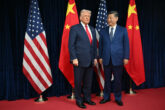September 07, 2017
Decoupling is back in Asia: A 1960s playbook won't solve these problems
It has been quite a summer in Pyongyang. Between July 4th, when it tested its first ICBM, and Labor Day weekend, when it detonated its sixth nuclear bomb — possibly a thermonuclear weapon — North Korea has presented the United States and the world with a new strategic reality. Pyongyang can use long-range missiles to reach almost any location in the United States, and likely has several dozen warheads. If it hasn’t fully miniaturized its nuclear capability yet, it is right on the cusp. And if its sixth nuclear test isn’t an H-bomb, it is least a boosted-fission weapon with the ability to devastate major cities. Observers should not cling hopefully to news of failed re-entry vehicles — North Korea is no longer a risible, rag-tag nuclear aspirant. For all intents and purposes, Pyongyang can hold much of the continental United States at risk and has functionally achieved a second-strike nuclear capability.
Read the full op-ed in War on the Rocks.
More from CNAS
-
North Korea Reveals Troop Dispatch to Russia amid U.S.-South Korea Policy Talks
North Korea has confirmed for the first time that its troops are operating in Russia, and it is preparing to rewrite its party charter with the possibility of officially namin...
By Dr. Go Myong-Hyun
-
Chinese Maker of Bitcoin-Mining Machines Is a Security Threat, Says Expert
Bloomberg News reports that a Chinese manufacturer, Bitmain Technologies Ltd, that sells most of the world’s Bitcoin-mining machines — including 16,000 of them to a venture ba...
By David Feith
-
Indo-Pacific Security / Energy, Economics & Security
North Korea’s Provocations, Power Plays, and Shifting AlliancesTensions on the Korean Peninsula have reached a new and dangerous threshold. President Lee Jae Myung is warning of a real risk of accidental military clashes, as the situation...
By Dr. Go Myong-Hyun
-
Indo-Pacific Security / Energy, Economics & Security
How to Win the Economic War with ChinaTrump's approach to China has run aground, giving Beijing unprecedented advantage in the economic conflict....
By Edward Fishman & Julian Gewirtz



